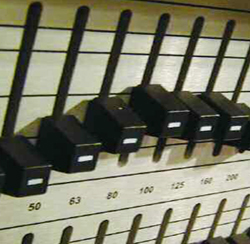
A couple of years ago marked the 40th anniversary of the Altec Lansing passive third-octave “continuous” equalizer that began modern sound system equalization.
It didn’t start as a graphic equalizer.
It was three rows of eight knobs on third octave centers. A companion third-octave real-time analyzer, three rows of eight VU meters, provided a means to measure a sound system.
Subsequent Altec EQs replaced the knobs with a row of sliders, earning the name “graphic” because their positions provide a graphic display of the equalizer’s response.
Today the favored device to quickly equalize temporary sound systems is still a graphic equalizer, with third-octave filters on standardized frequencies giving engineers a consistent set of EQ controls, as well as providing a universal vocabulary for describing a wide range of audio tones.
We won’t argue that there aren’t better ways of equalizing and optimizing the response of a sound system, but when time is tight, a good graphic EQ in the hands of a good engineer is “good enough.”
A quarter of a century ago, Crown and its Techron division unveiled the TEF System 10, the first portable Time Delay Spectrometry acoustical measurement system. Now owned by Gold Line, TEF provides near anechoic measurements due to its tracking filter.
Two decades ago, Meyer Sound developed source independent Fast-Fourier Transform measurement using Hewlett-Packard’s 3582A dual-channel FFT analyzer, released as SIM II in 1992 and updated in 2003 as SIM 3.
SIA Software and its Smaart put FFT onto laptop computers one decade ago, providing high-definition measurement to the average sound engineer.
Studio Six Digital, with its new FFT iPhone application, puts single-channel FFT measurement into the hands of the masses. With higher resolution, it becomes obvious that some frequency response problems aren’t fixable with the average equalizer, whether graphic or parametric.
Since their introduction, third octave graphic equalizers have been a standard in live sound, offering a set of overlapping filters that cover all frequencies. Professional sound systems employ one for each channel: two for stereo Front of House systems and one for each channel of floor monitors.
The original DN 30/30 from Klark Teknik, long ago replaced by the nearly identical DN360, has 30 combining third-octave filters, called such because of the overlap of a filter into the next filter’s control.
Described as variable bandwidth, these filters provide broader response at low boost or cut, which narrows with higher gain. This model has been updated with the DN370, which adds a couple of parametric notch filters and a variable high-pass.
Early on, engineers who understood the difference in filter types sometimes requested a Klark Teknik vintage DN27 instead, preferring its sharper filters over those of the DN360.
KT’s programmable DN3600 provided a choice of either filter type. Currently their venerable Helix DN9340 provides five graphic filter types, in addition to dual dynamic EQ filters, four notch filters, a dozen parametric filters per channel, and the companion moving fader Rapide remote, which also can control the graphic EQs on the XL8 and Pro6 from Midas.

